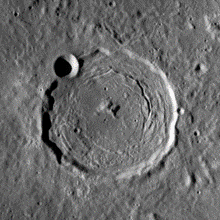The week of January 8-14 takes us from Day 27 to Day 4. This week we will highlight the moon crater Taruntius viewable on Sunday night and found in the NE quadrant of the Field Map at J4.
 Taruntius: [NE/J14; L=47°E] Taruntius is a wonderful example of a floor-fractured crater (FFC). Take a close look at it. Once you are familiar with the appearance of “normal” craters, you will notice right away that Taruntius has an unusually shallow basin. This is because hot magma underneath pushed upward with such force that the entire floor rose a little over a mile to its present level!
Taruntius: [NE/J14; L=47°E] Taruntius is a wonderful example of a floor-fractured crater (FFC). Take a close look at it. Once you are familiar with the appearance of “normal” craters, you will notice right away that Taruntius has an unusually shallow basin. This is because hot magma underneath pushed upward with such force that the entire floor rose a little over a mile to its present level!
Also notice the surrounding material that was ejected from the impact (the secondary craters) and the small moon crater Cameron that resulted from an object that hit precisely on the northwest rim. (Although Cameron looks small, it is nearly seven times larger than Meteor Crater in Arizona!) Cameron is a simple moon crater. Can you tell if it is bowl-shaped or does it have a flat floor? (In order to tell, you have to be observing when the rim shadow is crossing the floor.)
OF ADDITIONAL INTEREST IN SPACE
On Monday, Venus is 6° north of the Moon.
On January 13, 1610, Galileo discovers Jupiter’s moon Ganymede.
======================
It is highly recommended that you get a copy of Sky and Telescope’s Field Map of the Moon, the very finest Moon map available for use at the telescope. It is available for $10.95 at www.skyandtelescope.com and on Amazon. All features mentioned in this blog will be keyed to the grid on the Field Map and will look like this: Plato: [NW/D9]
Credits:
Courtesy of Gray Photography of Corpus Christi, Texas
Lunar photos: NASA / USGS / BMDO / LROC / ASU / DLR / LOLA / Moon Globe. Used by permission
- Rupes Recta – The Straight Wall on the Moon - April 29, 2024
- Trio of Moon Craters with Distinct Personalities - April 22, 2024
- Hippalus Rilles on the Moon - April 15, 2024